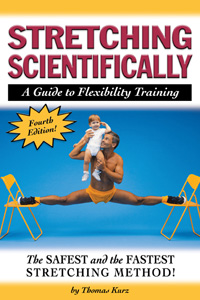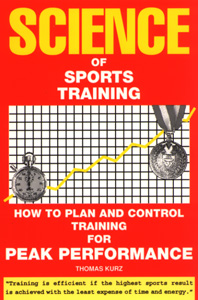by Thomas Kurz
In this article, I will continue answering questions on the proper sequence and timing of exercises.
Why do so many people train for hours weekly, year after year, and get such meager results? Some do the wrong exercises, but many do good exercises at the wrong time in a workout or in the long-term training program.
Question: Since reading your book and viewing the video Secrets of Stretching, I have decided to redo my workout routines. Even though I want to develop a workout that will improve my karate skills and flexibility, I also want to maintain and even improve my muscle mass in my upper body.
Here is what I have come up with:
Days 1, 2, 3, 5, and 6: Dynamic Stretching A.M. and P.M.
Days 1 and 6: Technical/Speed (techniques and kicking drills, sparring)
Days 2 and 5: Strength. I have listed the exercises in the order I do them. [The list of resistance exercises shows isolation exercises before complex movements (leg extensions and leg curls before squats and deadlifts), exercises for stabilizing muscles before the prime movers (deadlifts before hip adductors and hip flexor exercises, abdomen exercises before back extensions). This is all wrong. See my answer.—TK]
Day 3: Aerobics (endurance—jump rope, running/sprints, relaxed stretching)
Days 4 and 7: Off
What do you think?
Answer: Both the video Secrets of Stretching and the book Stretching Scientifically explain how to schedule workouts, but you managed to miss it. Your technical or speed workout should precede your strength or endurance workout, not as you show with strength on day 5 and speed or technique on day 6. Your strength workout should precede your endurance workout, which is to be followed by a day of complete rest or active rest (easy, fun activity). Do not do a technical or speed workout on the day immediately following either an exhausting strength or an exhausting endurance workout, and do not do a strength workout before fully recovering after an exhausting endurance workout because such sequences of efforts lead to overtraining.
In single workouts do not work on endurance before any other ability with the exception of static passive flexibility if you choose to develop it by relaxed stretches. Study Science of Sports Training for an in-depth explanation of why the same exercises give different results depending on their sequence in a workout and in the weekly sequence of workouts. By the way, sprints are not very aerobic.
Regarding your strength exercises, I suggest instead of leg curls and extensions, that you do more squats and deadlifts since they are better for your knees. By doing the deadlifts before adductor exercises, and abdomen crunches before back extensions, you break the rule of never fatiguing the stabilizers—in this instance, your back, which stabilizes your legs, or abdomen muscles, which stabilize your back—before the prime movers.
Question: In your article “Sequence of Conditioning Exercises for Martial Artists,” you said that in the course of a strength workout one should first train the legs, then the back, and finally the abdomen (you did not mention the upper body, because I take it these were specific exercises for taekwondo). If I wanted to do a whole body routine, where would the upper body fit in? Both my cousins, who are into bodybuilding (one is a fitness consultant), says that I should do my upper body first. Is this correct?
Answer: Generally, it would make sense to do the upper body first but there are exceptions to every rule. Think principle: Do not impair the muscles that will be the stabilizers in your next exercise.
Question: Please advise on the correct sequence of training for my situation. I am a martial artist with 20 years experience, however, my physical form is very poor due to a long-term health problem now fixed thanks to shoe inserts and applied kinesiology. I wish to regain physical form so I can train effectively with my peer group in black belt taekwondo classes. This is how I currently organize my training:
1) Warm-up/loosening of joints—5 minutes
2) Aerobic activity walk/jog—15–20 minutes
3) Martial art-specific warm-up—10 minutes
4) Main lesson—1 hour
5) Strength session—20–30 minutes. Exercises are adductor flys, sit-ups, leg strength, abdomen strength, back strength (At present I am only doing abdomen strength and back strength and will add the rest as I get stronger.)
6) Isometric stretches or relaxed stretches
This all is done on Monday, Wednesday and Saturday. All other days are rest days.
What do you think, am I on the right track or can I improve on this or is it all wrong? Please advise.
Answer: The sequence looks right. I would shorten your aerobic activity to maybe 5–10 minutes, perhaps combining it with loosening of your joints (in which case it may last over 10 minutes), and maybe extending the martial art-specific warm-up if needed. I would do the strength session as a separate workout—either a few hours later or on the next day. I prefer two short workouts, each dedicated to a different task, instead of one with different tasks (aerobic fitness, technique, overall body strength). You will find information on that in the book Science of Sports Training.
Question: I want to ask when to assume the horse-riding stance in a workout. After my kicking routine I usually go straight to weight training, but now I have decided to incorporate the horse-riding stance back into my workout. I do two sets of 5 min. stances after kicking as a warm-up before weight training. Should they be performed before or after weight training?
Answer: Generally, I would do static exercises such as stances after dynamic exercises such as lifting weights for reasons explained in the Science of Sports Training. Also, you should feel that after lifting weights you can sink deeper into the stance than before lifting.
Question: You have mentioned you like to perform high-rep exercises like Hindu squats after your strength workout. Where do these high-rep exercises fit in to the whole workout exactly—is it after heavy strength exercises and before isometric stretching? Are there other high-rep exercises you recommend besides push-ups and sit-ups, like for instance good mornings with no weight?
P.S.: These articles are the best source of training information I have come across. Thanks.
Answer: I do high reps after isometric stretching. Read the article “More Questions and Answers on Strength Exercises” where I explain their function and you will understand why.
I never tried really long sets of such back exercises as good mornings, deadlifts, and bench extensions—never felt the need nor any particular benefit, especially since I am not a rower. The most reps I have ever done in back extensions with a weight was 50. There are exercises involving back extension while standing but these are specific for grappling, do not resemble the aforementioned lifts, and I do them in long sets when the mood strikes me.
Question: I have trained in martial arts for many years and until I discovered the information by Tom Kurz my stretching routine was restricted to relaxed stretches (I could achieve a relaxed front and side split).
Since discovering Tom Kurz’s method I have been strengthening as recommended and have now incorporated it into my routine and have improved all around (including the quality of my front and side split).
At the end of my strength workout when I perform isometric tensions the first two sets I perform as recommended but on my third set I place my hands on the floor and lower myself using relaxed stretching (usually into a full split) and then apply isometric tension for 30 seconds. Is there any reason why I shouldn’t do this? It is very frustrating having good relaxed splits with my isometric spits trailing behind.
Answer: If you do not experience muscle soreness after such application of isometric tensions, then perhaps it is OK for you. I would expect great muscle soreness with your method of stretching and perhaps eventually a muscle injury. The fact that your range of motion in isometric stretches trails behind your range in relaxed stretches means that your muscles are not strong enough to support you at the ranges of movement greater than what you currently display in isometric stretches. Tensing muscles at a full split is better to arrive at gradually. The exercise seems good but you are doing it at the wrong time. Skipping stages of training can be very costly.
In the next article I will give you some “rules of thumb” for planning your training.
This article is based on the books Stretching Scientifically and Science of Sports Training and the video Secrets of Stretching. Get the books and the video now and have all of the info—not just the crumbs! Order now!
If you have any questions on training you can post them at Stadion’s Sports and Martial Arts Training Discussion Forum



